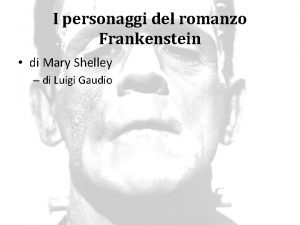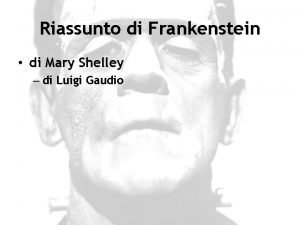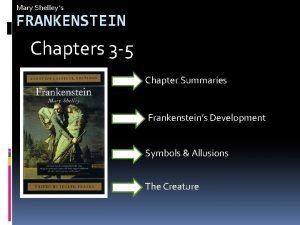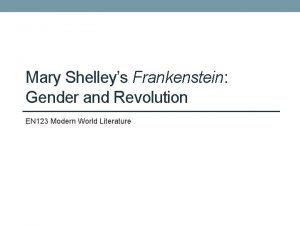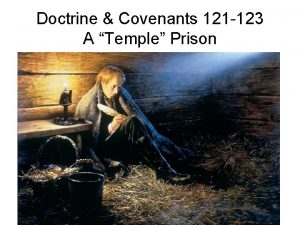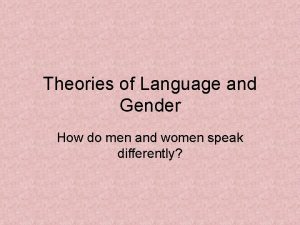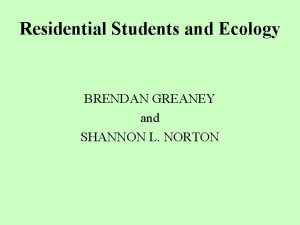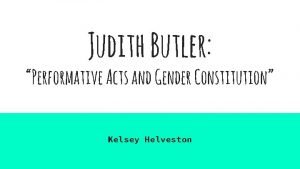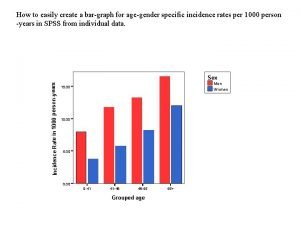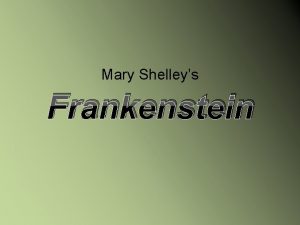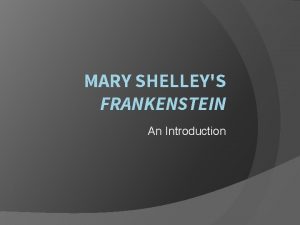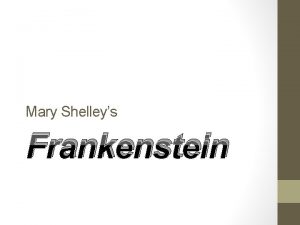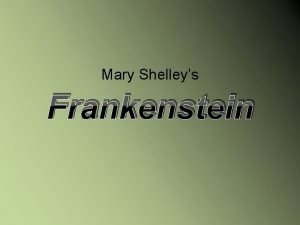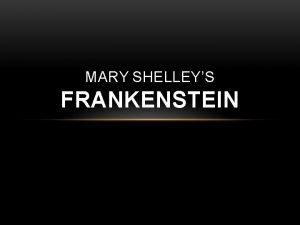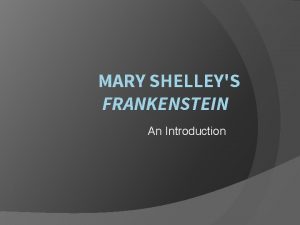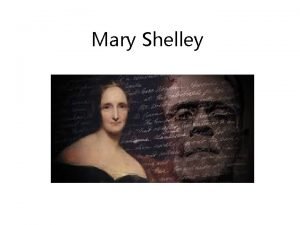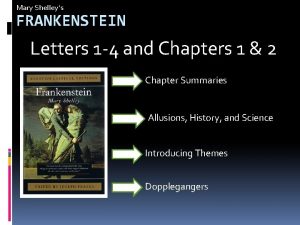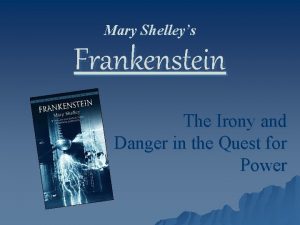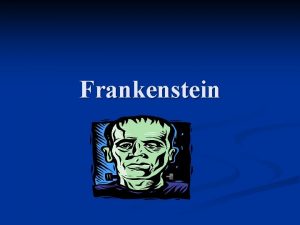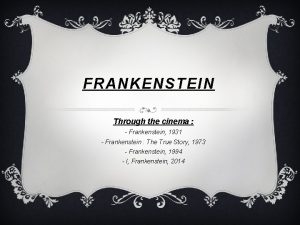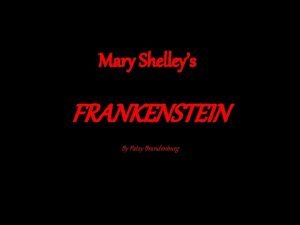Mary Shelleys Frankenstein Gender and Revolution EN 123














![15 “The transformation of the oppressed outcast into a grotesque being is [a] [. 15 “The transformation of the oppressed outcast into a grotesque being is [a] [.](https://slidetodoc.com/presentation_image/419cb9e16d879f19279ef38e7657b84b/image-15.jpg)





![21 “The Night Mare” The Anti-Jacobin Review (1799) “[S]ince I lost Shelley I have 21 “The Night Mare” The Anti-Jacobin Review (1799) “[S]ince I lost Shelley I have](https://slidetodoc.com/presentation_image/419cb9e16d879f19279ef38e7657b84b/image-21.jpg)
- Slides: 21

Mary Shelley’s Frankenstein: Gender and Revolution EN 123 Modern World Literature

2 science and discovery ‘the principle of life’ monstrosity gender sex class reproduction civilization Enlightenment revolution

3

4 Critical perspectives • Balfour, Ian. “Allegories of Origins: Frankenstein after the • • Enlightenment”. SEL Studies in English Literature 1500 -1900, 56. 4 (Autumn 2016): 777 -798. Benford, Criscillia. “‘Listen to my tale’: Multilevel Structure, Narrative Sense Making, and the Inassimilable in Mary Shelley's Frankenstein”. Narrative 18. 3 (October 2010): 324 -346. Burgess, Miranda. “Transporting Frankenstein: Mary Shelley's Mobile Figures”. European Romantic Review 25. 3 (May 2014): 247 -265. Clark, Anna E. "Frankenstein; Or, the Modern Protagonist. " ELH 81. 1 (Spring 2014): 245 -268. Cracuin, Adriana. “Writing the Disaster: Franklin and Frankenstein”. Nineteenth-Century Literature 65. 4 (2011): 433 -480.

5 Critical perspectives • Douthwaite, Julia V. and Daniel Richter. “The Frankenstein of the • • French Revolution: Nogaret’s Automaton Tale of 1790. ” European Romantic Review 20. 3 (July 2009): 381 -411. Hatch, James C. “Disruptive Affects: Shame, Disgust, and Sympathy in Frankenstein. ” European Romantic Review 19. 1 (January 2008): 33 -49. Houe, Ulf. “Frankenstein without Electricity: Contextualizing Shelley’s Novel. ” Studies in Romanticism 55. 1 (Spring 2016): 95 -117. Bernatchez, Josh. "Monstrosity, Suffering, Subjectivity, and Sympathetic Community in Frankenstein and ‘The Structure of Torture. ’” Science Fiction Studies 2 (2009): 205 -216. Scobie, Ruth. “Mary Shelley’s Monstrous Explorers: James Cook, James King, and a Sledge in Kamchatka. ” Keats-Shelley Review 27. 1 (April 2013): 8 -14.

6 Some questions • How does Shelley’s Frankenstein respond to the French Revolution and the contemporary political climate in Britain? • How does the novel position the rising status of scientific experimentation, the ‘voyage of discovery, ’ the debates and technologies associated with life and death? • What does the novel have to say about conflicts over gender, class, ‘civilization’ and Enlightenment? • What underlying contradictions of modernity inform the novel?

7 Francisco Goya, The Sleep of Reason Produces Monsters )c. 1797) Q. In what ways might ‘monstrosity’ be not a pre-modern relic, but instead a product of the modern, post-Enlightenment world?

8 Gender “Confronting the overlap between medical and sexual conceptualizations of the dead body, Mary Shelley’s novel Frankenstein explores the social dangers of the gendered relationship between male surgeons and female patients, as female sexuality doubles as the ultimate object of scientific enquiry. [. . . ] The novel draws on contemporary debates about surgery and medical practice in its analysis of the anatomist’s privileging of his medical research over his sexual desire for women, implying that the medical control and violation of women facilitates the rise of the male professional and a narrative of medical progress” (Emma Liggins, “The Medical Gaze And The Female Corpse: Looking at Bodies in Mary Shelley’s Frankenstein. ” Studies in the Novel 32. 2, 2000: 130)

9 “In the shared desires and similar barriers to belonging of Safie and the creature, Shelley connects political claims across racial, sexual and class differences [. . . ] in placing this dramatic example of feminist cultural rebellion at the heart of this novel littered with the bodies of ineffectual, passive or self-sacrificing women, Shelley expands the revolutionary political critique of her time, reviving a radical case for the rights of woman that had been vilified along with Wollstonecraft’s reputation. ” (Adriana Craciun, “Frankenstein’s Politics, ” in The Cambridge Companion to Frankenstein: 95)

10 Revolution “Perhaps no event so re-energised the discourse of monstrosity as did the French Revolution of 1789 -99. Elite opinion in Britain was at first largely unperturbed by the French events, often seeing them as a replay of Britain’s ‘Glorious Revolution’ of 1688, in which monarchs had been changed without a popular upheaval. But, by 1792, rulingclass opinion had shifted, coming over to the virulently antirevolutionary sentiment of Edmund Burke. ” (David Mc. Nally, Monsters of the Market, Leiden: Brill, 2011: 77)

11 “Mary Shelley picks up a way of seeing – the populace as a destructive monster – provided by Tory journalism and tries to re-think it in her own radical-liberal terms. And so in the novel the monster remains a monster – alien, frightening, violent – but is drenched with middle-class sympathy and given central space in the text to exercise the primary liberal right of free speech which he uses to appeal for the reader’s pity and understanding. The caricatured peoplemonster that haunts the dominant ideology is reproduced through Mary Shelley’s politics and becomes a contradictory figure, still ugly, vengeful and terrifying but now also human and intelligent and abused. ” (Paul O’Flinn, “Production and Reproduction: The Case of Frankenstein, ” Literature and History 9, 1983)

12 “The actions of the uneducated seem to me typified in those of Frankenstein, that monster of many human qualities, ungifted with a soul, a knowledge of the difference between good and evil. The people rise up to life; they irritate us, they terrify us, and we become their enemies. Then in the sorrowful moment of our triumphant power, their eyes gaze on us with mute reproach. Why have we made them what they are; a powerful monster, yet without the inner means for peace and happiness? ” Mary Gaskell, Mary Barton (1848) “[A] revolution in this country would not be bloodless if that man has any power in it. . . He encourages in the multitude the worst possible human passion revenge or as he would probably give it that abominable Christian name retribution. ” Mary Shelley to P. B. Shelley, on radical reformer William Cobbett (The Letters of Mary Wollstonecraft Shelley, ed. B. T. Bennett [1980], I: 49. )

13 “Like the proletariat, the monster is denied a name and an individuality. He is the Frankenstein monster; he belongs wholly to his creator (just as one can speak of ‘a Ford worker’). Like the proletariat, he is a collective and artificial creature. He is not found in nature, but built. Frankenstein is a productive inventor-scientist, in open conflict with Walton, the contemplative discoverer-scientist. … Reunited and brought back to life in the monster are the limbs of those—the ‘poor’—whom the breakdown of feudal relations has forced into brigandage, poverty and death. Only modern science—this metaphor for the ‘dark satanic mills’ —can offer them a future. It sews them together again, moulds them according to its will and finally gives them life” (Franco Moretti, “The Dialectic of Fear, ” New Left Review I: 136, Nov-Dec 1982: 69)

14
![15 The transformation of the oppressed outcast into a grotesque being is a 15 “The transformation of the oppressed outcast into a grotesque being is [a] [.](https://slidetodoc.com/presentation_image/419cb9e16d879f19279ef38e7657b84b/image-15.jpg)
15 “The transformation of the oppressed outcast into a grotesque being is [a] [. . . ] theme taken up and radicalised in Frankenstein. The monsterisation of the Irish [. . . ] was particularly significant in the era of Frankenstein. England’s first colony, Ireland had been subjected to the rigours of political anatomy, its lands expropriated, mapped and partitioned. As part of the legitimationstrategy entwined with this project, the Irish were racialised, depicted as a violent, disorderly and uncivilised breed. In fact, in his provocatively titled Political Anatomy of Ireland (1672), William Petty had described Ireland as ‘a Political Animal’ susceptible to anatomisation of the sort carried out on ‘common Animals’. The Irish were rebel-monsters in every sense. ” (David Mc. Nally, Monsters of the Market, Leiden: Brill, 2011: 84)

16 Timeline of the French Revolution (17891794) 1789 14 July - Storming of the Bastille 26 August - Declaration of the Rights of Man and of the Citizen 1792 13 August – Royal family imprisoned 2 -7 September – Massacres in Paris prisons 10 December – Start of trial against Louis XVI 1793 21 January – Execution of Louis XVI 17 September – Start of the Reign of Terror 16 October – Execution of Marie-Antoinette 1794 4 February – Decree to abolish slavery in France and French territories 28 July – Execution of Robespierre and end of the Terror

17 Timeline of the French Revolution (17891794) 1789 14 July - Storming of the Bastille 26 August - Declaration of the Rights of Man and of the Citizen 1792 13 August – Royal family imprisoned 2 -7 September – Massacres in Paris prisons 10 December – Start of trial against Louis XVI 1793 21 January – Execution of Louis XVI 17 September – Start of the Reign of Terror 16 October – Execution of Marie-Antoinette 1794 4 February – Decree to abolish slavery in France and French territories 28 July – Execution of Robespierre and end of the Terror

18 The men … who exist when the earth shall refuse itself to a more extended population, will cease to propagate, for they will no longer have any motive, either of error or duty, to induce them. In addition to this they will perhaps be immortal. The whole will be a race of men, and not of children. Generation will not succeed generation, nor will truth have in a certain degree to recommence her career at the end of every thirty years. There will be no war, no crimes, no administration of justice as it is called, and no government. . . Beside this, there will be neither disease, anguish, melancholy, nor resentment. William Godwin, Enquiry Concerning Political Justice (1793), Vol. II, pp. 872 -3.

19 Godwin and the Monstrous Burke called Godwin’s opinions “pure defecated atheism … the brood of that putrid carcase the French Revolution. ” […] The Anti-Jacobin Review, which championed the attack upon William Godwin and Mary Wollstonecraft, denounced the couple’s disciples in 1800 as “the spawn of the monster. ” (Lee Sterrenburg, “Mary Shelley's Monster: Politics and Psyche in Frankenstein, ” 1979: 146 -7) “[M]ost people felt of Mr. Godwin with the same alienation and horror as of a ghoul, or a bloodless vampyre, or the monster created by Frankenstein. ” (Thomas de Quincey, Tait’s Magazine, March 1837)

20 The Nightmare Henry Fuseli 1781
![21 The Night Mare The AntiJacobin Review 1799 Since I lost Shelley I have 21 “The Night Mare” The Anti-Jacobin Review (1799) “[S]ince I lost Shelley I have](https://slidetodoc.com/presentation_image/419cb9e16d879f19279ef38e7657b84b/image-21.jpg)
21 “The Night Mare” The Anti-Jacobin Review (1799) “[S]ince I lost Shelley I have no wish to ally myself to the Radicals – they are full of repulsion to me –violent without any sense of Justice – selfish in the extreme – talking without knowledge – rude, envious, and insolent – I wish to have nothing to do with them. ” Mary Shelley’s journal, October 1838
 Strategic gender needs and practical gender needs
Strategic gender needs and practical gender needs Romanticism
Romanticism Frankenstein ch 3 summary
Frankenstein ch 3 summary Mary shelley frankenstein biography
Mary shelley frankenstein biography Frankenstein ch 14 summary
Frankenstein ch 14 summary Main themes in frankenstein
Main themes in frankenstein Literary devices in frankenstein
Literary devices in frankenstein Frankenstein personaggi
Frankenstein personaggi Frankenstein riassunto capitoli
Frankenstein riassunto capitoli Chapter summaries of frankenstein
Chapter summaries of frankenstein Frankenstein french revolution
Frankenstein french revolution Mary wollstonecraft mary a fiction
Mary wollstonecraft mary a fiction Russian revolution vs french revolution
Russian revolution vs french revolution How could the french revolution have been avoided
How could the french revolution have been avoided Green revolution vs third agricultural revolution
Green revolution vs third agricultural revolution Doctrine and covenants 121-123
Doctrine and covenants 121-123 Deborah tannen difference theory
Deborah tannen difference theory Gender roles in snow white
Gender roles in snow white Gender-neutral housing pros and cons
Gender-neutral housing pros and cons Butler performative acts
Butler performative acts Gender interpersonal communication
Gender interpersonal communication Age and gender bar graph
Age and gender bar graph







